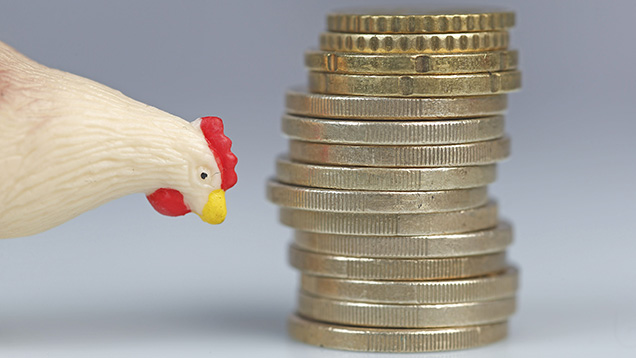Profits surge in global poultry business
 © Ismo Pekkarinen/Rex Shutterstock
© Ismo Pekkarinen/Rex Shutterstock Strong markets and low feed costs mean poultry production in most parts of the world is profitable, and the outlook for margins looks good.
According to the latest Poultry Quarterly from analysts Rabobank, the global industry is benefiting from “ongoing bullish market fundamentals”.
Supply is balanced, competing meat prices are high and feed costs are low.
The worsening economic situation in Asia and Latin America is also seen to be potentially beneficial for the poultry sector, as consumers in places such as Brazil, Thailand, India and Russia “trade down” to poultrymeat from more expensive beef and pork.
See also: How US free-trade negotiations threaten UK poultry
Avian influenza (AI) remains a major concern for the global industry, adds the report, with new outbreaks cropping up in most regions in the world, except Australia and South America.
Regional outlook for the poultry industry
EU
 Strong market conditions with healthy balance and restrictive supply growth. Weak euro also compensates for loss of sales due to AI outbreaks.
Strong market conditions with healthy balance and restrictive supply growth. Weak euro also compensates for loss of sales due to AI outbreaks.
US
 Strong margins despite AI trade bans. Bullish domestic demand is making up for lost exports.
Strong margins despite AI trade bans. Bullish domestic demand is making up for lost exports.
Brazil
 Weak local economy leads to trading-down effect, lifting poultry consumption. Export trade benefited hugely from others’ AI problems.
Weak local economy leads to trading-down effect, lifting poultry consumption. Export trade benefited hugely from others’ AI problems.
China
 Some improvement in poultry markets due to increasing pork prices. Shortages of breeding stock will tighten the market in 2016.
Some improvement in poultry markets due to increasing pork prices. Shortages of breeding stock will tighten the market in 2016.
Russia
 Improved performance due to lower feed costs and price support from high beef and pork values. Consolidation also ongoing.
Improved performance due to lower feed costs and price support from high beef and pork values. Consolidation also ongoing.
However, the number of outbreaks has been lower in recent months, and this offers the industry in affected regions some time to recover.
“The performance in most regions is currently improving, but the industry should have optimal biosecurity as its first priority, as avian influenza pressure is still significant,” says report author Nan-Dirk Mulder.
“Any new case can have a big impact on regional and global trade streams, as we have seen in the past months.”
In particular, Brazil and Thailand have taken further market share from the US and China, he notes.
The US has been affected by AI and its strong currency, while China has lost market share due to food safety concerns.
“Brazil took over several of the lost US markets in Asia, while Thailand gained market share from Brazil in Europe and replaced a significant part of the former Chinese exports to Japan.”
Outlook
Rabobank believes the outlook for late 2015 and 2016 is “bullish”, as feed prices are expected to remain competitive, and global breeding stock supply will be reduced in regions with AI-related import restrictions, such as China and South-East Asia.
“The expectation that China will face a shortage in poultry and pork supply next year could especially become a major swing factor for the global poultry industry,” says Rabobank.
The expected further spread of AI to key US chicken producing areas in the autumn is also a “major wild card” for the industry outlook in the second half of this year. For now, however, the US poultry industry is still making “record-high profits”.
“Global poultrymeat trade will keep growing, but trade streams and prices will remain volatile,” the report concludes.
